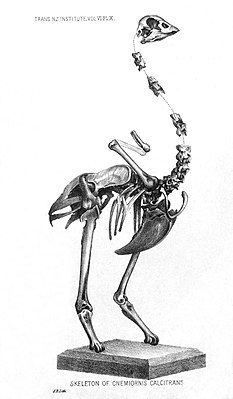South Island giant goose
| South Island giant goose | ||||||||||
|---|---|---|---|---|---|---|---|---|---|---|

South Island giant goose ( Cnemiornis calcitrans ) |
||||||||||
| Systematics | ||||||||||
|
||||||||||
| Scientific name | ||||||||||
| Cnemiornis calcitrans | ||||||||||
| Owen , 1866 |
The South Island giant goose ( Cnemiornis calcitrans ) is an extinct water bird from the duck bird family . It was endemic to New Zealand's South Island . Together with the somewhat lighter North Island giant goose ( Cnemiornis gracilis ) it forms the extinct genus of the New Zealand geese ( Cnemiornis ).
features
With a back height of 65 centimeters, a length from head to tail of 85 centimeters and a weight of 18 kilograms, the South Island giant goose was the largest known New Zealand water bird. It was a stocky bird with a short and thick beak. Legs and pelvis were strong. The skeleton identifies them as a close relative of the Australian chicken goose . In contrast to the chicken goose, which can fly very well, the South Island giant goose was flightless. This is indicated by the reduced wings and the receding chest keel. Between the toes were spurs that the South Island giant goose probably used in fights. According to Richard Owen, who described the species in 1866, "the South Island giant goose was probably able to kick more violently than the kiwi".
Way of life and extinction
Like most geese, the South Island giant goose presumably flocked and fed on grasses. The subfossil remains of around 250 discovered specimens suggest that the South Island giant goose was mainly found in the eastern, arid regions of the South Island. It roamed the open terrain and experienced its heyday in the Pleistocene, when the formation of grass and bushland was favored by the colder climate.
The South Island giant goose probably became extinct due to overhunting and disappeared around 1400.
Systematics
While most taxonomists consider the South Island giant goose to be the sister taxon of the chicken goose, the paleontologist Bradley C. Livezey was of the opinion in 1996 that the genus Cnemiornis does not belong to the geese due to phylogenetic relationships and therefore suggested the independent family Cnemiornithidae. Livezey's classification was revised in 1997 by Trevor H. Worthy on the basis of DNA analyzes of the first complete skeleton available and on the basis of further cladistic studies .
literature
- A. Tennyson and P. Martinson: Extinct birds of New Zealand. Te Papa Press, 2006, ISBN 0-909010-21-8 .
- Trevor H. Worthy & Richard N. Holdaway: The Lost World of the Moa. Prehistoric Life of New Zealand. Indiana University Press, Bloomington 2002, ISBN 0-253-34034-9 .
- Walter Rothschild (1907): Extinct Birds . P. 97.
- Trevor H. Worthy & Richard N. Holdaway: A reappraisal of the late Quaternary fossil vertebrates of Pyramid Valley Swamp, North Canterbury, New Zealand . In: New Zealand Journal of Zoology, 1997, Vol. 24: pp. 69-121 0301-4223 / 2401-069.
Web links
- Information about the genus Cnemiornis (English)
- Cnemiornis calcitrans by Paul Martinson. Illustration from Extinct Birds of New Zealand , by Alan Tennyson, Te Papa Press, Wellington, 2006
Individual evidence
- ↑ Richard Owen: On Dinornis (Part X): containing a description of part of the skeleton of a flightless bird indicative of a new genus and species Cnemiornis calcitrans, Ow., With remarks on its affinities in the in the lamellirostral group . In: Transactions of the Zoological Society of London 5: 395-404. 1866
- ↑ Bradley C. Livezey (1996), A phylogenetic analysis of geese and swans (Anseriformes: Anserinae), including selected fossil species . Syst. Biol. 45: pp. 415-450
- ↑ Trevor H. Worthy, Richard N. Holdaway, MD Sorenson & AC Cooper (1997), Description of the first complete skeleton of Cnemiornis calcitrans Owen, (Aves: Anatidae), and a reassessment of the relationships of Cnemiornis. J. Zool., Lond. 243: 695-723.